Jarry Park Stadium
Jarry Park Stadium (French: Stade Parc Jarry [stad paʁk ʒaʁi]) is a tennis stadium in Montreal, Quebec, Canada. It was formerly a baseball stadium, home to the Montreal Expos (today's Washington Nationals), from 1969 to 1976. The Expos were Major League Baseball's first Canadian franchise. It served as a temporary home (for eight seasons) until the domed Olympic Stadium was finished and made available to the Expos. The ballpark was typically called simply (and inaccurately, since the stadium was built within the larger park) "Jarry Park" or Parc Jarry. The stadium hosted two National Football League preseason games in 1969; August 25 (Detroit Lions vs Boston Patriots) and September 11 (New York Giants vs Pittsburgh Steelers).
Stade Parc Jarry | |
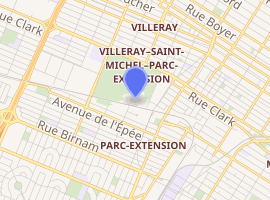
| |
| Location | Montreal |
|---|---|
| Coordinates | 45°31′58″N 73°37′37″W |
| Owner | City of Montreal |
| Capacity | 3,000 (1960) – 28,456 (1969) |
| Field size | Left field – 340 ft (103 m) Left-centre – 368 ft (112 m) Centre field – 420 ft (128 m) Right-centre – 368 ft (112 m) Right field – 340 ft (103 m) Backstop – 60 ft (18 m) |
| Surface | Grass |
| Opened | August 1960 (Baseball) |
| Closed | September 26, 1976 (Baseball) |
| Tenants | |
| Montreal Expos (MLB) (1969–1976) | |
The stadium originally began as a baseball field in Montreal's north end (Villeray) in a public park known as Jarry Park. The only structure was the small unroofed grandstand behind the home plate and backstop area, with seating for approximately 3,000 people.
.jpg)
History (1960-present)
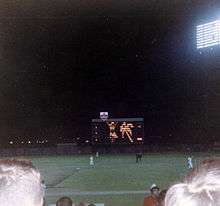
Before Jarry Park Stadium, Montreal's main baseball stadium was Delorimier Stadium, the longtime home of the Montreal Royals. The diamond at Jarry Park had simply hosted youth baseball on a field in the park. However, in early 1960 the Montreal Royals were dropped by the Los Angeles Dodgers as an affiliate.[1]

Looking to improve facilities for a stadium in Montreal, the 3,000 seat Jarry Park Stadium was built, formally opening in August 1960. After the Dodgers ended their affiliation with the Royals, potential new owners of the team had an option on the franchise, with the provision that a suitable ballpark is put in place. Unable to negotiate an agreement to play at the aging Delorimier Stadium, the group looked to spacious Jarry Park as the alternate site. The Jarry Park Stadium was built for this reason. However, even after the construction, the Royals franchise relocated to Syracuse, New York in 1960.[1]
When the original baseball field was later approved for the Expos, it was renovated to a park approaching major league standards. Unroofed extensions were built from the original stands to the left and right field corners, a large bleacher section was constructed across the left field, and a scoreboard was built behind the right-field fence. This work brought the stadium's capacity to 28,500, and the park was approved as the Expos temporary home.
Features and dimensions
Beyond the right field fence was a pre-existing swimming pool in the city park. Long before the "splash hits" at Oracle Park in San Francisco and PNC Park in Pittsburgh, there were occasional "splash hits" here. The first and most famous was a 495 ft (151 m) blast by Willie Stargell on July 23, 1969—leading locals to call the pool "Willie's pool" (French: la piscine de Willie). One of those was hit by Willie McCovey during a 6-4 win over the Expos on August 24, 1969. The idea of the swimming pool itself was later replicated in Chase Field in Phoenix.
The stadium was rather sparse, given that it was intended to be only a temporary home for a maximum of four years. The clubhouses were located along the left-field line behind the stands. Due to its orientation, games in April and September frequently started with the setting sun shining right in the faces of first basemen. Eventually, it was decided to delay games until the sun finished setting. It was completely exposed to the elements, which was a particular problem at the beginning and end of the season, given Montreal's long winters. There was a huge gap between the left-field bleachers and the third-base grandstands, resulting in second basemen and shortstops getting buffeted by cold winds early and late in the season. The Expos frequently had to postpone early and late-season games because there was no protection for the fans. Even allowing for its temporary status, the field conditions were among the worst in the majors.
Although the center field distance was posted as 420 feet (130 m), it was actually 417 feet (127 m) to straightaway center, and 420 feet (130 m) to the deep left and right center field corners.
Montreal Expos
In their first expansion since 1962, Major League Baseball added four new franchises for the 1969 season. Along with San Diego, Seattle and Kansas City, Montreal was granted a Major League franchise. This marked the first time a team was located outside of the United States. Montreal, Canada's largest city at the time, had a strong tradition with minor league baseball, as the Montreal Royals were a long time Dodgers farm team. Jackie Robinson had played for the Royals in 1946, before his promotion to the Dodgers in 1947, breaking the color barrier. Icon Roberto Clemente was another Montreal Royal player, as were Dodgers legends Duke Snider, Don Drysdale, Roy Campanella and Tommy Lasorda. At the time the major league expansion announcement was made, Montreal had just hosted the 1967 World's Fair, called Expo '67, opened a new subway system and submitted (and eventually won) an international bid to host the 1976 Summer Olympic Games.[2]
Owner Charles Bronfman called the new franchise the Expos (after the World's Fair) and hired Gene Mauch as Manager.[3]
When the Expos were announced as an expansion franchise in 1967, one condition for placing an MLB franchise in Montreal was that a domed stadium—thought to be a must due to Montreal's harsh winter weather—be in place for the 1972 season. Finding a site for the Expos to play until that time proved to be a challenge. Delorimier Stadium was ruled out because its location made it impossible to expand beyond its 20,000-seat capacity (it was eventually demolished in 1971). Other options were the Autostade from Expo 67,[4] a World's fair which had inspired the new club's nickname. However, the city balked at the cost of adding a dome and 12,000 seats, and the Canadian Football League's Montreal Alouettes demanded onerous rent.
The Expos were now in a bind—if they did not find another site quickly, the National League would strip Montreal of its franchise and award it to Buffalo, which already had a suitable stadium in place. In August 1968, Montreal Mayor Jean Drapeau persuaded National League President Warren Giles to visit Jarry Park (Parc Jarry). Giles liked the site's location—less than a mile from a highway and 200 yards from a commuter railroad.
After settling in at Jarry Park Stadium, a strike delayed the original 1972 completion of a domed stadium. Due to further delays and cost overruns, the Expos wound up playing eight seasons in Jarry Park.[5][6] After Montreal was selected in 1970 to host the 1976 Summer Olympic Games, the stadium projects of the baseball team and of the Summer Olympic Games merged. When it became apparent that Olympic Stadium would not be ready in time, the Expos were forced to seek permission from MLB to stay at Jarry Park Stadium for one more season. Further construction delays eventually forced the Expos to repeat the process until Olympic Stadium was finally ready for baseball for the 1977 season. For a time during the 1976–77 offseason, it looked like the Expos would have to open the 1977 season at Jarry Park due to delays in securing a lease at Olympic Stadium; indeed, the Expos began selling 1977 season tickets under the assumption they would have to play at Jarry. However, an agreement was finally reached in early 1977, allowing the Expos to open 1977 at the new Olympic Stadium.[7]
On the field, the Expos finished 52-110 in their first year. They improved over the years, winning over 70 games in 1970, 1971 and 1972 and came close to the .500 mark in both 1973 and 1974. Their most popular player during the Jarry Park era was Rusty Staub, nicknamed "le Grand Orange."[5] Other players of note at Jarry Park were: Maury Wills, Willie Davis, Ron Fairly, Carl Morton, Ken Singleton and Ron Hunt. Future Hall of Famer Gary Carter debuted in 1974 at age 20. Warren Cromartie, Steve Rogers, Larry Parrish, Ellis Valentine and the great Andre Dawson were all young Expos who played their debut seasons at Jarry Park.[8]
The Washington Nationals honored Jarry Park during the 50th-anniversary celebration of their franchise at Nationals Park July 6, 2019, by replicating the Expos' original scoreboard.
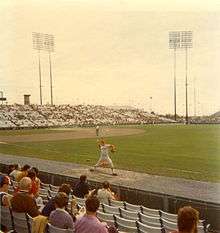
No-hitter
One Major League no-hitter was pitched at Jarry Park. On October 2, 1972, in the first game of a doubleheader against the New York Mets, Bill Stoneman pitched the first MLB no-hitter outside the United States as Montreal won 7-0.[9][10]
Notable baseball moments at Jarry Park
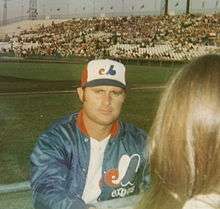
1969 Attendance Despite Jarry Park Stadium being the smallest venue in Major League Baseball, the Expos drew 1.2 million fans in 1969.[11]
April 14, 1969: In the first Major League Baseball regular season game in Canada, the Montreal Expos defeated the St. Louis Cardinals, 8–7.[12]
1970 Jarry Park served as the home of both an MLB team and a Class AAA team in 1970. The Buffalo Bisons (Class AAA; International League) played 13 home games in Jarry Park.[11]
September 29, 1971: Batting against Milt Pappas of the Chicago Cubs, Ron Hunt was hit by a pitch for the 50th time during the season. The Expos won, 6-5, on Hunt's game-winning single in the ninth inning.[13]
May 9, 1972: Willie Mays plays in his final game as a member of the San Francisco Giants. As a pinch-hitter, he gets a single in the ninth inning of a 7-1 Giants' loss to the Expos.[14]
September 9, 1973: A year and a half following his last appearance as a member of the San Francisco Giants, Willie Mays plays the final regular-season game of his career as the Mets defeated the Expos, 3-0, despite 13 Montreal hits.[15]
September 15, 1973: A crowd of 34,331 (the largest ever at Jarry Park Stadium) watches the Expos defeat the Philadelphia Phillies, 5-4. Bob Bailey singles home Ron Woods with the winning run in the 10th inning.[16]
September 28, 1974: Gary Carter hits his first major league home run off Phillies' pitcher Steve Carlton. The Expos win, 3-1.[17]
September 26, 1976: In the last baseball games played at Stade Parc Jarry, the Phillies won both games of a doubleheader, 4-1 and 2-1 (the second game shortened to seven innings due to rain), over the Expos. The win in the first game gave the Phils' their first National League East Division title.[18][19]
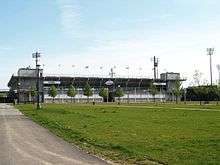
The site today
The stadium was used for various civic events in the years after the Expos. The Inter-Montreal soccer team of Canadian Professional Soccer League (CSPL) played at Jarry. Jarry Park Stadium was gradually converted into a tennis stadium, beginning in 1980, with one corner of the court located at the old backstop.[1] The stadium was renamed in honor of Pope John Paul II to mark his visit to Montreal and the park on September 11, 1984. The venue was renamed Du Maurier Stadium in 1987. It has since been upgraded and renamed again, most recently as Stade IGA.
Today, Jarry Park contains baseball diamonds, soccer, cricket, bocce, basketball and beach volleyball grounds, pitches and zones, swimming pools and playgrounds, a dog run, and two gazebos. In winter a pond is swept to make a skating rink.[20]
See also
- Jarry Park
- IGA Stadium
References
- "Jarry Park (Montreal) - Society for American Baseball Research". sabr.org. Retrieved 21 January 2018.
- http://www.geisleryoung.com/, Geisler Young, LLC -. "Washington Nationals History and Montreal Expos History on Baseball Almanac". www.baseball-almanac.com. Retrieved 21 January 2018.
- "Montreal Expos (1969-2004)". www.sportsecyclopedia.com. Retrieved 21 January 2018.
- "Montreal mapping its baseball future". Milwaukee Journal. May 29, 1968. p. 14, part 2.
- "Clem's Baseball ~ Jarry Park". www.andrewclem.com. Retrieved 21 January 2018.
- Keri, Jonah (2014). Up, Up and Away. Toronto: Random House Canada. ISBN 9780307361356.
- Costello, Rory. Olympic Stadium (Montreal). Society for American Baseball Research, 2013.
- "Washington Nationals Team History & Encyclopedia - Baseball-Reference.com". Baseball-Reference.com. Retrieved 21 January 2018.
- "October 2, 1972 New York Mets at Montreal Expos Box Score and Play by Play". Baseball-Reference.com. Retrieved 2009-01-14.
- "October 2, 1972 New York Mets at Montreal Expos Box Score and Play by Play". Baseball-Reference.com. Retrieved 2009-01-14.
- "Jarry Park / Montreal Expos / 1969-1976". ballparkdigest.com. 5 April 2009. Retrieved 21 January 2018.
- "April 14, 1969 St. Louis Cardinals at Montreal Expos Box Score and Play by Play". Baseball-Reference.com. Retrieved 2009-01-14.
- "September 29, 1971 Chicago Cubs at Montreal Expos Box Score and Play by Play". Baseball-Reference.com. Retrieved 2009-01-14.
- "May 9, 1972 San Francisco Giants at Montreal Expos Box Score and Play by Play". Baseball-Reference.com. Retrieved 2009-01-14.
- "September 9, 1973 New York Mets at Montreal Expos Box Score and Play by Play". Baseball-Reference.com. Retrieved 2009-01-14.
- "September 15, 1973 Philadelphia Phillies at Montreal Expos Box Score and Play by Play". Baseball-Reference.com. Retrieved 2009-01-14.
- "September 28, 1974 Philadelphia Phillies at Montreal Expos Box Score and Play by Play". Baseball-Reference.com. Retrieved 2009-01-14.
- "September 26, 1976 Philadelphia Phillies at Montreal Expos Box Score and Play by Play". Baseball-Reference.com. Retrieved 2009-01-14.
- "September 26, 1976 Philadelphia Phillies at Montreal Expos Box Score and Play by Play". Baseball-Reference.com. Retrieved 2009-01-14.
- "montreal.com - jarry park". www.montreal.com. Archived from the original on 9 June 2017. Retrieved 21 January 2018.
External links
- Stade Uniprix official site
- Jarry Park Today
- Expos Historical Society: Jarry Park
- Baseball Chronology: Jarry Park
- Ballparks by Munsey and Suppes: Jarry Park
- Jarry Park Photos: http://digitalballparks.com/National/ParqJarry.html
| Preceded by None |
Home of the Montreal Expos 1969–1976 |
Succeeded by Olympic Stadium |